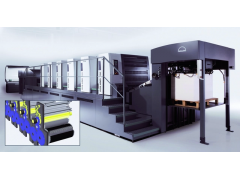From manufacturing and operations to sustainability and design, the future belongs to service providers, not product distributors. This means that in the coming years, customers will be able to enjoy an all-encompassing shopping experience, where companies often provide a holistic experience that appeals to customers mentally, emotionally, and sensorially, rather than just a few branded items.
As technology develops, mass manufacturing will shift to creative, niche brand packaging to support certain goods and services. It’s clear that technology and packaging will combine to spark a new business revolution. So even though everyone is familiar with traditional paper bottles, bags and cartons, things may change dramatically in the future. But first, we need to consider the two main forces shaping the future of the packaging industry - sustainability and e-commerce.
The growth of online shopping and the drive for sustainable development
E-commerce has made huge strides in its early days. With no in-store experience and no access to customer service departments during lockdown, e-commerce is fast becoming the primary method of purchase, overtaking traditional retail. With the advent of new cutting-edge packaging technologies, the packaging industry now has a wealth of opportunities to further specialize and customize its products given the growth of e-commerce as a key method of purchase.
E-commerce is a key determinant of the future of the packaging industry, as the e-commerce buying experience becomes increasingly customized from start to finish, led by giants like Amazon. But as mentioned earlier, this is not the primary motivation.
Keeping the Earth in Order
The second major driver for the future of the packaging industry is sustainability. Sustainability has become a clear trend for many businesses, even outside of packaging. Consumers have already begun to shift towards green purchases, and this trend is becoming more and more common. In addition, even though the prices of environmentally friendly solutions are becoming increasingly unaffordable, consumers are still spending more on these goods. According to Survey Monkey, one-third of customers prefer environmentally friendly alternatives, and 35 percent of respondents would rather buy an environmentally friendly product than a slightly cheaper one.
Sustainability has become a major concern in the packaging industry as more and more companies are committed to environmental protection and customers are becoming more aware of and demanding higher standards of eco-responsibility. Following trends such as recycling, reducing waste, using cartons more efficiently, and reducing carbon footprint has begun to become more and more common. As a result, sustainable packaging may replace traditional packaging, although plastic packaging is still widely used as the new standard.
When imagining the packaging of the future, one indisputable change to consider is the depletion of plastic resources. Plastic is widely used, convenient and durable, but it has come under increasing criticism for its impact on the environment. The stark reality of plastic pollution has stirred the collective conscience, prompting businesses and consumers to look for more sustainable alternatives. This has led to people embracing cutting-edge materials and technologies to create a better, healthier world.
Therefore, as customer expectations for everything to be as simple and eco-friendly as possible evolve, creative improvements and technological breakthroughs are needed to create new profitable opportunities for companies. Examples of these demands include the popularity of e-commerce and sustainable development. Fortunately for them, the industry is experiencing a technological rebirth, with new technologies and packaging designs hitting the shelves on a regular basis. However, which innovative packaging methods are we talking about? Let’s start exploring!
Suitable alternatives
By reducing our reliance on plastic, edible packaging offers a creative and environmentally friendly alternative that reduces our need for fossil fuels and has the potential to significantly reduce our carbon footprint. It’s a great way to meet growing customer demand for environmentally friendly initiatives.
Edible packaging has huge potential, offering the food industry a wide range of flexible alternatives to packaging colors, patterns and other aspects by using natural materials such as algae, plant fibers, seaweed or crops. Customers can even consume the box, which provides a one-of-a-kind experience and ensures that nothing is left in the ocean or landfill. However, edible packaging is not just for end-use by customers. Unlike typical plastics that harm animals, certain edible packaging options are safe for animals.
Compact and adaptable packaging
Innovation isn’t limited to how customers discard packages, however. Transportation and storage are also evolving. The large-scale manufacturing, transportation, and storage of packaging can also have a negative impact on the environment, as excess stock ends up in landfills. Fortunately, however, space-saving alternatives are becoming more common thanks to recent advances and greater efficiency.
This shows that flexible packaging is becoming increasingly popular for efficient stacking, storage and handling. Flexible packaging is one of the hottest trends, especially for the food industry where customers want variety and ease of use. It is strong, lightweight and very flexible, suitable for products of various shapes and sizes. Flexible packaging minimizes waste and reduces its impact on the environment while making storage, transportation and consumption simple. Examples of this packaging include resaleable stand-up pouches, convenient sachets and bags. Customers and the environment benefit from its innovative features, including portion control and improved product protection, as well as the efficient use of resources.
Smart technology packaging
If you thought edible flexible packaging was already highly developed, you might be surprised to learn that more cutting-edge inventions are becoming popular in the market. The term "smart packaging," another name for "intelligent active packaging," has become very popular recently. With the ability to easily observe and record consumer behavior, smart packaging can provide a more customized experience for the target market, opening up new areas of communication for brands and businesses, helping them better meet customer needs.
Printed electronics in the form of advanced infotainment, digital sales tools and online connectivity, near field communication (NFC), radio frequency identification (RFID), ambient intelligence, smart LED/OLED, compact power supplies, screens, sensors and data storage enable customers to interact with products at an unprecedented level. Bio-nanocomposites have ideal hygienic and antimicrobial packaging protection properties, especially for medical, pharmaceutical and food packaging, and have the potential to replace non-biodegradable petroleum-based plastics.
Nanotechnology is also being used to reduce packaging waste and sustainability. With nanotechnology, we have only begun to scratch the surface of its possibilities. More innovations are sure to follow, and even augmented reality, long confined to science fiction, is now within reach. The advent of augmented reality (AR) technology has already shown how interactive technology will continue to influence packaging design in the future.
In the next 10 years, as companies use packaging and products to build their brands and provide new ways to entertain, consumers will be able to digitally test drive things, see the possibilities of packaging, and participate in gaming components. In summary, smart technology will not only increase the interactivity of products, but also provide rich customer data, helping to provide customers with more quantifiable results and advantages.
Material trends: corrugated packaging, flexible packaging and sustainability
We’ve already talked about the growth of smart packaging and design trends, but what about materials? In fact, materials follow the same e-commerce and environmentally driven principles as new packaging designs. Although we’ve previously mentioned flexible and edible packaging as design trends, it’s also important to highlight the materials they’re made of.
The use of natural materials as viable alternatives to popular packaging materials such as plastic is increasing rapidly. Examples of these materials include bamboo, plant fibers, and starch for food and other sustainable packaging solutions. Although plastics are still in use, the market for flexible packaging materials is expanding rapidly. Given the growing popularity of e-commerce, changing dietary preferences, and the abundance of processed and packaged foods, flexible packaging remains a good alternative to traditional plastic packaging. This is because it uses fewer resources, thereby reducing waste, requires less space for transportation, and extends the shelf life of food and beverages.
The last material that is not new but still popular is corrugated. The corrugated box material industry is worth $155 billion. This is because the e-commerce sector is expanding. Despite some of the disadvantages of corrugated material, it is still a wise choice due to its durability, economy and recycling ability.
Manufacturing Advances with 3D Printing
In the world of packaging, it’s not just designs and materials that are changing. The manufacturing industry is also evolving. The development of innovative techniques and the discovery of effective new technologies are making it easier than ever to create custom packaging.
Additive manufacturing has captured our attention in recent years due to its ability to produce complex forms and patterns on demand that are impossible or very resource-intensive using traditional production methods. 3D printing is expected to set higher standards in the future through print-to-order production. With its versatility, efficiency and cost-effectiveness, 3D printing will become a better alternative to existing technologies for packaging prototyping, blurring the lines between design and manufacturing.
Although 3D printing is still in its early stages, scalable printing for multiple fields is likely to replace limited, specialized manufacturing! Additive manufacturing technology will provide customized, on-demand packaging solutions limited only by the user's creativity as early as 2028.
AI-driven smart warehousing and machine automation
Although smart packaging has been discussed previously in this article, there are other uses for this cutting-edge technology. In our more connected world, customers have come to expect customized goods to be shipped quickly. This is possible because of cutting-edge technologies such as cognitive computing, robotic process automation (RPA), IoT connectivity, and more.







